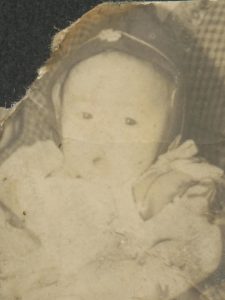Documenting Hiroshima of 1945: September 29, two-year old boy with severe facial wounds unable to survive
Sep. 29, 2024
by Kyosuke Mizukawa, Senior Staff Writer
On September 29, 1945, Toshiharu Iwamoto died after experiencing the atomic bombing at only two years of age. He had been at home in the area of Higashikaniya-cho (in Hiroshima’s present-day Higashi Ward), where he lived with his family of five, including mother, two older sisters, and an older brother. He suffered severe wounds to his face that had not healed nearly two months later.
His older brother, Eizo Iwamoto, 84, a resident of the town of Kumano-cho in Hiroshima Prefecture, was five years old at the time of the bombing. With a troubled expression, he said, “On the morning of August 6, I was eating breakfast with my family. Toshiharu was right in front of the window.” Their home was located about three kilometers to the east of the hypocenter. Eizo only suffered minor injuries, but shards of window glass broken by the blast gouged out an area on Toshiharu’s face between his left eye and left ear. Blood gushed from the wound. Shards from the broken glass also struck the face of his older sister, Akiko, who ultimately survived but was bleeding from the cuts.
Yoshiko Fukada, their older sister, aged 15 at the time, who died in 2022 at the age of 92, later created paintings of her two siblings’ wounds based on her memories of that time. She added a note to the paintings that reads, “My heart ached, because I thought my little brother and sister would have been safe if only I had been hurt instead.” On the morning of that day she had been sitting down between Toshiharu and the window, but she changed seats just before the bomb detonated.
Toshiharu was so fond of Yoshiko, he would not cry in the absence of his mother so long as his older sister was around. In her personal account, Yoshiko wrote, “He would call me ‘Otei-chan.’ Even though the wounds to his face had not healed, he called me ‘Otei-chan’ and cried while clinging to me.”
Recalling his brother, Eizo also said softly, “I remember I used to carry him on my back. He was a cute boy.” To receive treatment for his wounds, his mother carried Toshiharu in her arms to a relief station on the city’s outskirts and elsewhere, but her efforts were in vain.
According to a Hiroshima City government survey of victims of the atomic bombing (as of the end of fiscal 2012), of the 62,410 victims whose names and ages had been identified and who had died by the end of 1945, children aged zero through nine years of age numbered 7,714, or around 12 percent of the total number of victims.
(Originally published on September 29, 2024)
On September 29, 1945, Toshiharu Iwamoto died after experiencing the atomic bombing at only two years of age. He had been at home in the area of Higashikaniya-cho (in Hiroshima’s present-day Higashi Ward), where he lived with his family of five, including mother, two older sisters, and an older brother. He suffered severe wounds to his face that had not healed nearly two months later.
His older brother, Eizo Iwamoto, 84, a resident of the town of Kumano-cho in Hiroshima Prefecture, was five years old at the time of the bombing. With a troubled expression, he said, “On the morning of August 6, I was eating breakfast with my family. Toshiharu was right in front of the window.” Their home was located about three kilometers to the east of the hypocenter. Eizo only suffered minor injuries, but shards of window glass broken by the blast gouged out an area on Toshiharu’s face between his left eye and left ear. Blood gushed from the wound. Shards from the broken glass also struck the face of his older sister, Akiko, who ultimately survived but was bleeding from the cuts.
Yoshiko Fukada, their older sister, aged 15 at the time, who died in 2022 at the age of 92, later created paintings of her two siblings’ wounds based on her memories of that time. She added a note to the paintings that reads, “My heart ached, because I thought my little brother and sister would have been safe if only I had been hurt instead.” On the morning of that day she had been sitting down between Toshiharu and the window, but she changed seats just before the bomb detonated.
Toshiharu was so fond of Yoshiko, he would not cry in the absence of his mother so long as his older sister was around. In her personal account, Yoshiko wrote, “He would call me ‘Otei-chan.’ Even though the wounds to his face had not healed, he called me ‘Otei-chan’ and cried while clinging to me.”
Recalling his brother, Eizo also said softly, “I remember I used to carry him on my back. He was a cute boy.” To receive treatment for his wounds, his mother carried Toshiharu in her arms to a relief station on the city’s outskirts and elsewhere, but her efforts were in vain.
According to a Hiroshima City government survey of victims of the atomic bombing (as of the end of fiscal 2012), of the 62,410 victims whose names and ages had been identified and who had died by the end of 1945, children aged zero through nine years of age numbered 7,714, or around 12 percent of the total number of victims.
(Originally published on September 29, 2024)









